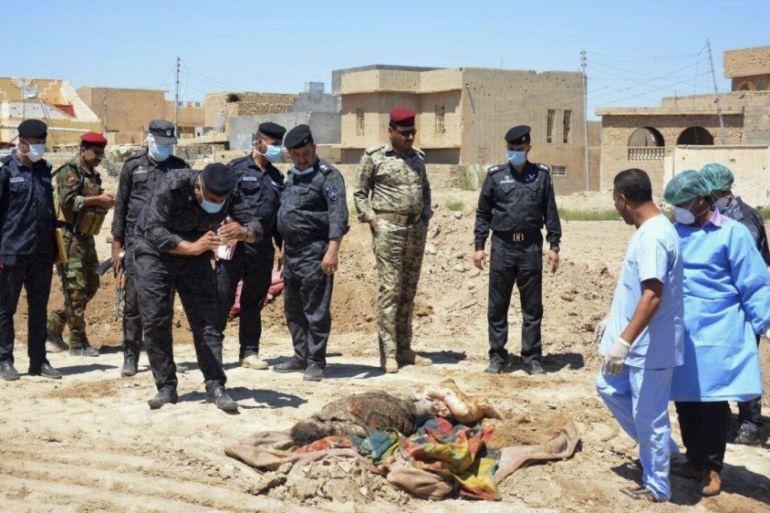Investigation: ISIL buried thousands in 72 mass graves
Thousands of people killed by ISIL are believed to be buried in 72 mass graves in Iraq and Syria.

The Islamic State of Iraq and the Levant (ISIL) group has buried thousands of their victims in at least 72 mass graves across Iraq and Syria, according to exclusive interviews, photos and research conducted by the Associated Press news agency.
In what amounts to the most comprehensive survey of ISIL massacre sites to date, AP obtained locations of 17 mass graves in Syria, including one with the bodies of hundreds of members of a single tribe all but exterminated when ISIL took over their region.
Keep reading
list of 4 itemsAustin confirms Russians deployed to airbase housing US military in Niger
What’s next as ‘heavy-handed’ US negotiates pullout from Niger?
Putin says ‘radical Islamists’ behind Moscow concert hall attack
Of the 72 mass graves documented in the investigation, the smallest contained three bodies; the largest is believed to hold thousands, but no one knows for sure.
ISIL, also known as ISIS, has made no attempt to hide its atrocities. In fact it boasted of them. But proving what United Nations officials and others have described as an ongoing genocide – and prosecuting those behind it – will be complicated as the graves deteriorate.
In its own propaganda, ISIL made clear its intention to wipe out the Yazidi community.
The Yazidi faith, one of the region’s oldest, has elements of Christianity and Islam but is distinct. In an issue of its online English-language magazine Dabiq, ISIL scolded Muslims for allowing the Yazidis to continue existing, calling their ancient religion a form of paganism.
|
|
“We see clear evidence of the intent to destroy the Yazidi people,” said Naomi Kikoler, who recently visited the region for the Holocaust Museum in Washington DC.
“There’s been virtually no effort to systematically document the crimes perpetrated, to preserve the evidence, and to ensure that mass graves are identified and protected.”
Nearly all of the areas recaptured from ISIL control have unmasked new graves, many of which are covered with just a thin coating of earth.
“They don’t even try to hide their crimes,” said Sirwan Jalal, the director of Iraqi Kurdistan’s agency in charge of mass graves.
“They are beheading them, shooting them, running them over in cars, all kinds of killing techniques, and they don’t even try to hide it.”
Steve Wood, from the satellite intelligence agency AllSource, said: “Ultimately there are many, many more sites across Iraq and Syria that have yet to be either forensically exhumed or be able to be detailed,” adding that there is “more research that needs to take place”.
The key to uncovering hidden sites, Wood said, is having photographs to indicate a grave’s location that has been taken soon after its creation.
READ MORE: Iraq hangs 36 men over 2014 Camp Speicher massacre
Ongoing conflict is hindering the ability of officials to develop estimates of the likely number of ISIL mass graves. For example, at least 16 of the grave sites discovered in Iraq are, as it currently stands, too dangerous to investigate.
In the meantime, estimates of the numbers killed and dumped in mass graves are currently based on the reports of traumatised survivors, ISIL propaganda and what can be gleaned from a cursory look at the Earth from satellite and other imagery.
On August 21, Iraq hanged 36 men convicted over the 2014 ISIL mass killing of hundreds of Iraqi soldiers at Camp Speicher, where about 1,700 army recruits were forced to lie face-down in a ditch and then get machine-gunned.
The hanging suggests that the government is eager to implement hardline consequences for perpetrators.
![Iraqi soldiers salute as they stand next to a mass grave for soldiers killed by ISIL [Reuters]](/wp-content/uploads/2016/08/fdf50bd0b4634674bcfed9eb405e61ee_18.jpeg)
But justice is likely to be elusive in areas still firmly occupied by ISIL, even though the group’s fighters regularly have regularly filmed themselves committing the atrocities.
Activists believe there are hundreds of mass graves in ISIL-controlled areas of Syria that can only be explored when fighting stops.
By that time, they fear any effort to document the massacres, exhume and identify the remains will become infinitely more complicated.